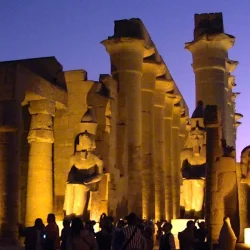Medinet Habu Temple, located on the West Bank of Luxor in Egypt, is one of the most significant and well-preserved temples from the New Kingdom period. Dedicated to the god Amun and built by Pharaoh Ramesses III, it serves as a monument to his reign and military achievements, and it is a prime example of ancient Egyptian temple architecture and artistry.
While its neighbor, the Ramesseum, boasts immense size, Medinet Habu holds its own historical significance. This sprawling complex, also known as the Mortuary Temple of Ramses III, offers a captivating glimpse into life and death in ancient Egypt.
Medinet Habu Temple Historical Background

Medinet Habu, also known as the Mortuary Temple of Ramesses III, was constructed during the 20th Dynasty, around 1186-1155 BCE. The temple complex was designed to serve both as a place of worship for the god Amun and as a mortuary temple for the deified pharaoh. Ramesses III is often considered the last great monarch of the New Kingdom, and his temple reflects the grandeur and ambition of his reign.
Medinet Habu Temple Architectural Features
The temple complex at Medinet Habu is extensive, covering an area of over 7,000 square meters. Its design follows the traditional layout of New Kingdom mortuary temples, but it also includes unique elements that highlight its importance and the power of Ramesses III.
- First Pylon and Courtyard: The temple is entered through a massive pylon, adorned with reliefs depicting Ramesses III in battle and religious scenes. This leads to the first courtyard, which features the pharaoh’s victory scenes over the Sea Peoples, a confederation of naval raiders who threatened Egypt during his reign.
- Second Pylon and Hypostyle Hall: The second pylon leads to the hypostyle hall, a grand space filled with massive columns. The walls and columns are intricately decorated with scenes of the pharaoh offering to the gods and various religious ceremonies.
- Sanctuary and Inner Chambers: The inner sanctum of the temple houses the sanctuary dedicated to Amun. Surrounding chambers were used for various religious rituals and storage of temple treasures and offerings.
- Royal Palace: Adjacent to the temple is a royal palace complex that was used by Ramesses III. This area includes residential quarters, administrative offices, and reception halls, reflecting the dual role of the complex as both a religious and administrative center.
- Chapels and Auxiliary Buildings: The temple complex also includes chapels dedicated to other deities, storehouses, and granaries. These auxiliary buildings highlight the economic and religious activities that took place within the temple grounds.
Artistic and Cultural Significance

Ramses III’s temple is the centerpiece of Medinet Habu. This well-preserved structure is a textbook example of New Kingdom mortuary temple architecture. Step through the fortified gatehouse, resembling an Asiatic fortress, and enter a world adorned with captivating reliefs. The walls come alive with scenes depicting Ramses III’s victories in battle, particularly his famous defeat of the Sea Peoples, a mysterious group of invaders who threatened Egypt‘s borders. These detailed carvings offer invaluable insights into military strategies and weaponry of the time.
Medinet Habu is renowned for its detailed and vivid reliefs, which provide valuable insights into the religious, political, and military aspects of Ramesses III’s reign. The temple’s walls are a rich tapestry of historical records, depicting scenes of battles, royal ceremonies, and offerings to the gods.
The reliefs of Ramesses III’s battles against the Sea Peoples are particularly notable. These detailed carvings offer one of the few contemporary accounts of these mysterious invaders and the military strategies employed by the Egyptians to repel them.
Preservation and Modern Relevance
The temple complex at Medinet Habu has been remarkably well-preserved, thanks in part to its solid construction and the dry climate of the region. It remains one of the best-preserved temples from the New Kingdom, allowing archaeologists and historians to study its art, architecture, and inscriptions in detail.
Medinet Habu isn’t just a celebration of military prowess. The temple walls also showcase rituals, processions, and offerings made to the gods. One particularly interesting section portrays the beautiful “Festival of Opet,” a ceremony where statues of the god Amun and his consort Mut were paraded along a processional way. These scenes provide a window into the religious life of the ancient Egyptians and their elaborate rituals.
A City Within a City
Medinet Habu wasn’t just a temple; it was a bustling religious and administrative center. Within the fortified enclosure, you’ll find chapels dedicated to other deities, storage rooms, workshops, and even the remains of a royal palace. Imagine a microcosm of ancient Egyptian life existing alongside the temple, catering to its needs and perpetuating the pharaoh’s legacy.
Today, Medinet Habu is a significant archaeological site and a major tourist attraction. It provides visitors with a glimpse into the grandeur of ancient Egyptian civilization and the power and piety of Pharaoh Ramesses III. The temple stands as a testament to the architectural ingenuity and artistic achievements of ancient Egypt, continuing to captivate and educate people from around the world.
Medinet Habu stands as a testament to the power and artistry of ancient Egypt. Exploring this unique complex allows visitors to appreciate the architectural mastery of the New Kingdom, delve into the life and accomplishments of Ramses III, and gain a deeper understanding of the multifaceted nature of Egyptian temples. So, next time you’re planning a trip to Luxor, don’t miss the chance to step beyond the Ramesseum and discover the captivating stories whispered by the walls of Medinet Habu.












0 Comment